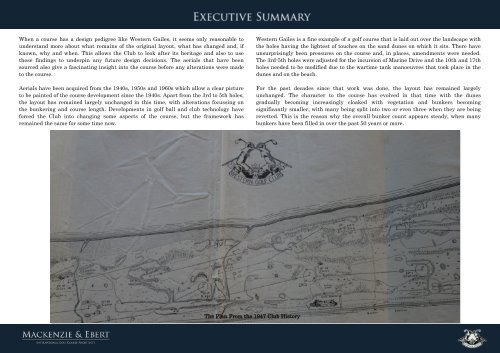Create successful ePaper yourself
Turn your PDF publications into a flip-book with our unique Google optimized e-Paper software.
When a course has a design pedigree like <strong>Western</strong> <strong>Gailes</strong>, it seems only reasonable to<br />
understand more about what remains of the original layout, what has changed and, if<br />
known, why and when. This allows the Club to look after its heritage and also to use<br />
these findings to underpin any future design decisions. The aerials that have been<br />
sourced also give a fascinating insight into the course before any alterations were made<br />
to the course.<br />
Aerials have been acquired from the 1940s, 1950s and 1960s which allow a clear picture<br />
to be painted of the course development since the 1940s. Apart from the 3rd to 5th holes,<br />
the layout has remained largely unchanged in this time, with alterations focussing on<br />
the bunkering and course length. Developments in golf ball and club technology have<br />
forced the Club into changing some aspects of the course, but the framework has<br />
remained the same for some time now.<br />
<strong>Western</strong> <strong>Gailes</strong> is a fine example of a golf course that is laid out over the landscape with<br />
the holes having the lightest of touches on the sand dunes on which it sits. There have<br />
unsurprisingly been pressures on the course and, in places, amendments were needed.<br />
The 3rd-5th holes were adjusted for the incursion of Marine Drive and the 10th and 17th<br />
holes needed to be modified due to the wartime tank manoeuvres that took place in the<br />
dunes and on the beach.<br />
For the past decades since that work was done, the layout has remained largely<br />
unchanged. The character to the course has evolved in that time with the dunes<br />
gradually becoming increasingly cloaked with vegetation and bunkers becoming<br />
significantly smaller, with many being split into two or even three when they are being<br />
revetted. This is the reason why the overall bunker count appears steady, when many<br />
bunkers have been filled in over the past 50 years or more.<br />
The Plan From the 1947 Club History


